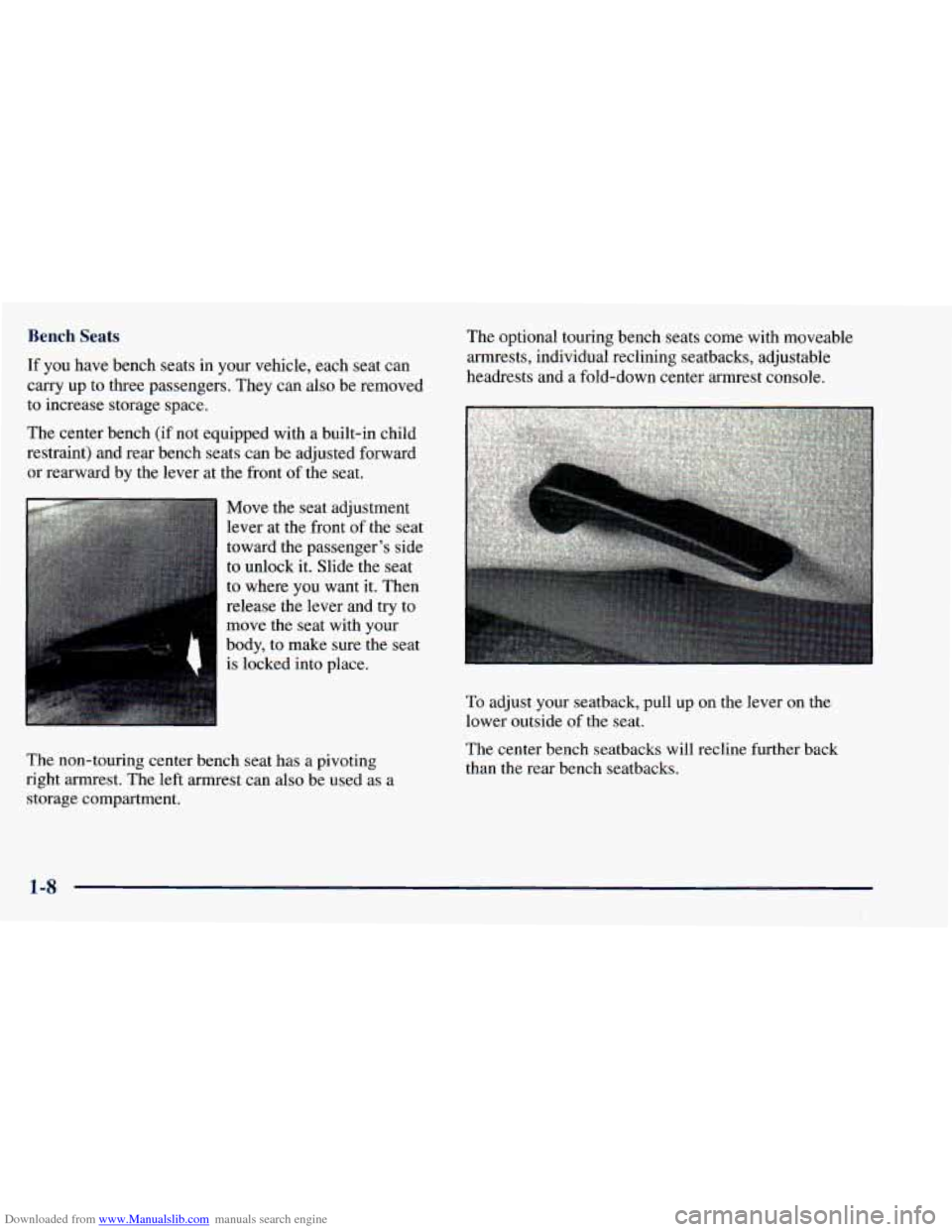Page 20 of 414
Downloaded from www.Manualslib.com manuals search engine 0
RELEASE
To fold your non-touring
seatback forward, pull up on
the latch release lever while
pulling the seatback toward
the rear
of the vehicle.
After the latch has been released, push the seatback
toward the front of the vehicle until it locks in place.
To
raise the seatback, unlock the seatback latch by pushing
up
on the lever while pushing down on the upper edge
of the seatback. Move the seatback into the upright
position. Make sure the seatback is locked when it is
back
in the upright position.
A CAUTION:
If the seatback isn’t locked, it could move
forward in a sudden stop or crash. That could
cause injury to the person sitting there, Always
press rearward on the seatback to be sure it
is locked.
Rear Seats
I
A seat that isn’t locked into place properly can
move around in a collision or sudden stop. People
in the vehicle could be injured. Be sure to lock
the seat into place properly when installing it.
1-6
Page 22 of 414

Downloaded from www.Manualslib.com manuals search engine Bench Seats
If you have bench seats in your vehicle, each seat can
carry up to three passengers. They can also be removed
to increase storage space.
The center bench (if not equipped with a built-in child
restraint) and rear bench seats can be adjusted forward
or rearward by the lever at the front of the seat.
Move the seat adjustment
lever at the front
of the seat
toward the passenger’s side
to unlock it. Slide the seat
to where you want it. Then
release the lever and try to
move the seat with
your
body, to make sure the seat
is locked into place. The
optional touring bench seats come with moveable
armrests, individual reclining seatbacks, adjustable
headrests and
a fold-down center armrest console.
The non-touring center bench seat has a pivoting
right armrest. The left armrest can also be used as a
storage compartment. To
adjust your seatback, pull up on the lever on the
lower outside of the seat.
The center bench seatbacks will recline further back
than the rear bench seatbacks.
1-8
Page 211 of 414

Downloaded from www.Manualslib.com manuals search engine /1 CAUTION:
Do not load your vehicle any heavier than the
GVWR, or either the maximum front or rear GAWR.
If you do, parts on your vehicle can
break, or it can change the way your vehicle
handles. These could cause you to lose control.
Also, overloading can shorten the life of
your vehicle.
Using heavier suspension components to get added
durability might not change your weight ratings.
Ask
your dealer to help you load your vehicle the right way.
NOTICE:
~
Your warranty does not cover parts or
components that fail because of overloading.
If you put things inside your vehicle -- like suitcases,
tools, packages, or anything else
-- they will go as fast
as the vehicle goes. If
you have to stop or turn quickly,
or
if there is a crash, they’ll keep going.
A CAUTION:
Things you put inside your vehicle can strike and
injure people in a sudden stop or turn, or in a crash.
0 Put things in the cargo area of your vehicle.
0 Never stack heavier things, like suitcases,
Try to spread the weight evenly.
inside the vehicle
so that some of them are
above the tops of the seats.
Don’t leave an unsecured child restraint in
your vehicle.
When you carry something inside the
vehicle, secure it whenever you can.
0 Don’t leave a seat folded down unless you
need to.
Payload
The Payload Capacity is shown on the Certificatiooire
label. This is the maximum load capacity that your
vehicle can carry. Be sure to include the weight of the
people inside as part
of your load. If you added any
accessories or equipment after your vehicle left the
factory, remember
to subtract the weight of these things
from
the payload. Your dealer can help you with this.
4-27